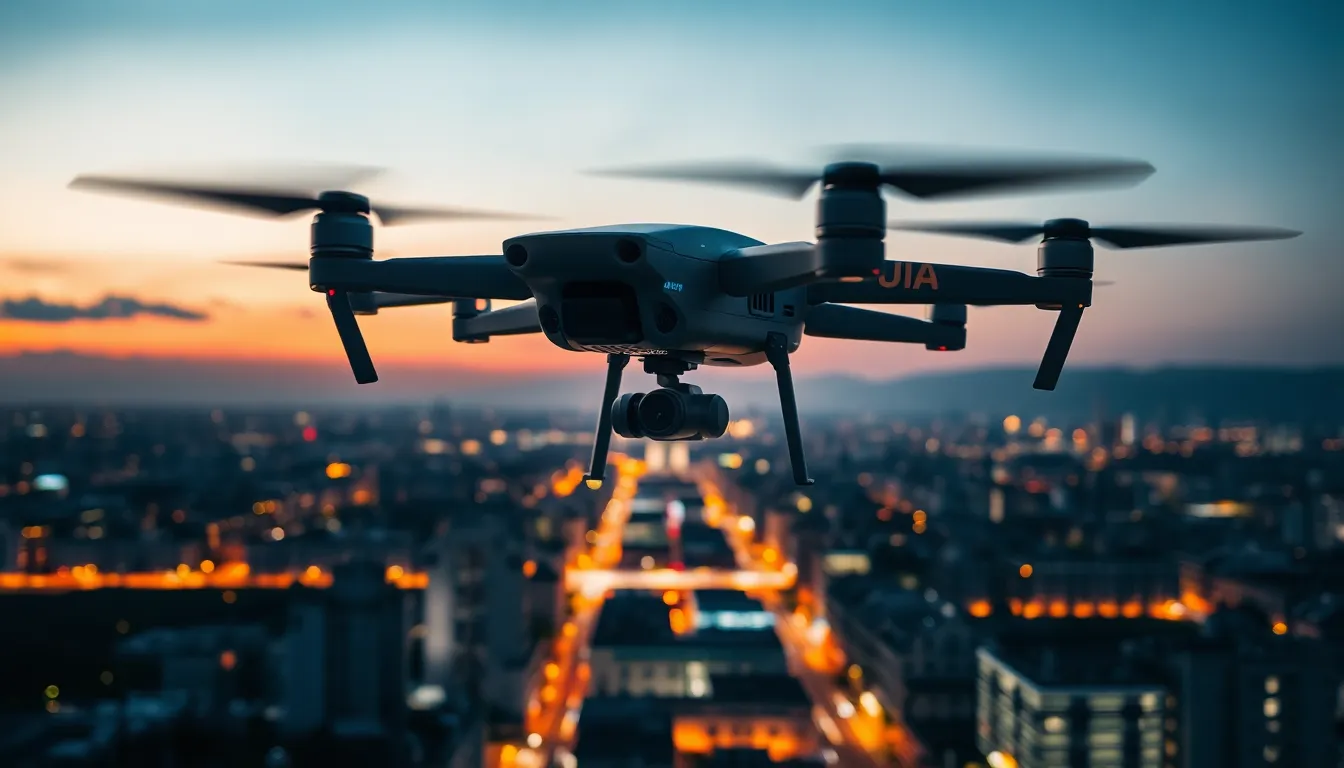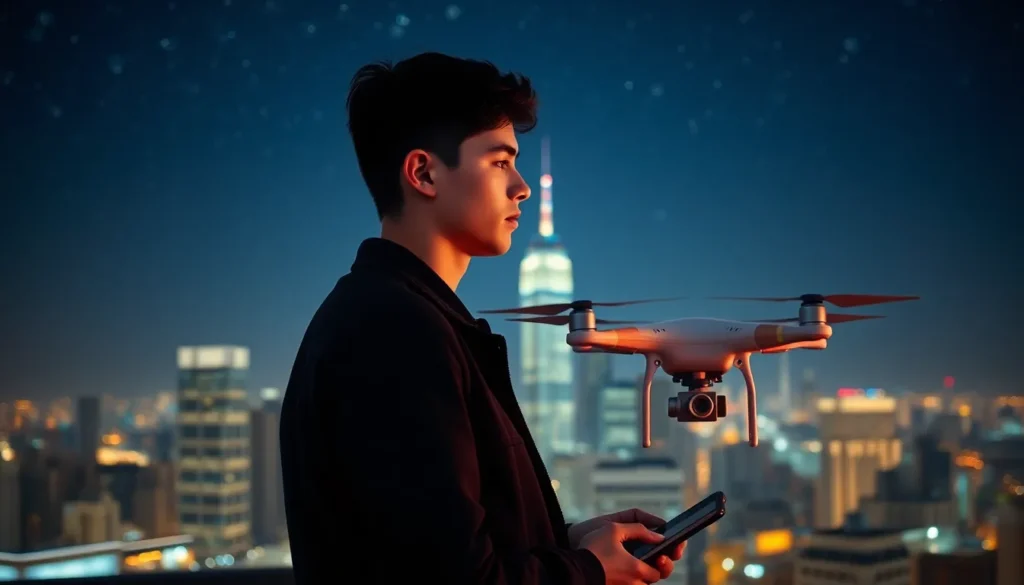When the sun dips below the horizon and darkness blankets the world, a magical realm of photography awaits. Drones for night photography have taken the art of capturing stunning visuals to new heights—literally. Imagine soaring above a cityscape, where twinkling lights paint a breathtaking canvas and the stars seem to wink at you. It’s not just about capturing the moment; it’s about elevating it.
Table of Contents
ToggleOverview of Drones for Night Photography
Drones designed for night photography possess unique features that cater to capturing low-light conditions. High-quality cameras equipped with larger sensors enable drones to gather more light, essential for vibrant images. Advanced stabilization systems ensure steady shots, reducing motion blur during nighttime flights.
Several models offer adjustable ISO settings, allowing photographers to control light sensitivity. This flexibility aids in reducing noise while maintaining detail in dark environments. Additionally, drones with RAW image formats provide more editing latitude, enhancing post-processing capabilities.
Battery life becomes a vital consideration for night photography. Drones that offer extended flight times allow for prolonged shooting sessions, which is crucial when capturing fleeting moments of light. Some models even feature intelligent flight modes, enabling automated capture of preset shots.
Light pollution remains a challenge in urban areas yet presents opportunities for creativity. Drones can easily navigate through these settings while avoiding obstacles. Photographers often use filters to minimize glare and enhance the natural colors of the environment.
Weather conditions also impact night photography experiences. Cloud cover and humidity can obscure visibility, so monitoring forecasts is essential for planning successful flights. Using drones equipped with thermal sensors can help identify suitable locations even in low visibility.
Lastly, incorporating safety measures ensures a successful night flight. Utilizing illuminating navigation lights helps secure visibility for both the drone operator and the drone itself. Compliance with local regulations regarding nighttime flights promotes safety and adds to the enjoyment of capturing stunning aerial images at night.
Key Features to Consider

Selecting a drone for night photography involves several key features that enhance shooting quality and overall experience.
Camera Quality
Camera quality stands out as a primary factor. High-resolution sensors contribute to sharp images in low-light conditions. Drones equipped with larger sensors gather more light, producing clearer and more detailed photos. Adjustable ISO settings provide additional versatility, allowing photographers to fine-tune light sensitivity based on ambient conditions. Integrating lenses with wide apertures further enhances the ability to capture stunning visuals, even in darker settings. Manufacturers such as DJI and Sony offer models renowned for their excellent camera capabilities.
Flight Time
Flight time greatly affects shooting sessions. Longer battery life ensures extended periods in the air, crucial for capturing vibrant nighttime scenes. Many drones offer flight times ranging from 20 to 30 minutes, though this can vary based on payload and environmental factors. Knowing the drone’s power management features can also extend operational times. Accessories like extra batteries enhance flexibility, allowing photographers to cover more ground during nighttime outings.
Stability and Control
Stability and control play essential roles in achieving crisp nighttime photos. Advanced stability systems minimize vibrations and motion blur, crucial for long exposure shots. Many drones come with GPS-assisted hovering features, helping maintain position even in windy conditions. User-friendly control interfaces allow for seamless adjustments, ensuring smooth operation during flights. Drones with intelligent flight modes can also automate complex shots, offering additional support for photographers aiming for precision in low-light environments.
Best Drones for Night Photography
Drones designed for night photography vary significantly in features and price. Selecting the right drone enhances the quality of nighttime imagery.
High-End Options
Top-tier drones often feature advanced cameras with larger sensors that excel in low-light scenarios. The DJI Mavic 3 is notable for its 20 MP sensor and impressive low-light performance. Another excellent choice is the Autel Robotics EVO Lite+, equipped with an adjustable aperture and 50 MP camera, ensuring stunning details at night. These drones incorporate advanced stabilization systems to reduce motion blur, even in windy conditions. Battery life reaches up to 40 minutes, allowing extended sessions for capturing dynamic cityscapes and starry skies. Features like intelligent flight modes further simplify the shooting process, making it easier to create breathtaking nighttime visuals.
Budget-Friendly Choices
Affordable drones offer viable options without sacrificing image quality. The DJI Mini SE stands out with a 12 MP camera and a lightweight design, making it easy for enthusiasts to operate during evening shoots. The Holy Stone HS720 also deserves recognition for its solid performance, providing 4K video capabilities and decent stabilization at a lower price point. Users can expect flight times of around 26 minutes, which is sufficient for capturing important moments. These budget-friendly choices often include user-friendly controls, ensuring that even beginners can produce quality nighttime photographs without complications.
Tips for Capturing Stunning Night Photos
Capturing stunning night photos with drones requires careful planning and technique. Preparation enhances the likelihood of achieving remarkable results.
Equipment Preparation
Selecting the right drone is vital. High-quality cameras equipped with larger sensors dramatically improve low-light performance. Ensure batteries are fully charged to maximize flight time. Check propellers for damage, as functional equipment is essential for stability. Additionally, using filters can help reduce glare from artificial lights, allowing for clearer images. Prepare backup memory cards, as high-resolution photos consume significant storage. Familiarize yourself with your drone’s settings, focusing on ISO, shutter speed, and aperture, to get the best from your shoots.
Techniques for Low Light
Utilizing long exposure settings works wonders. It captures more light, enhancing visual detail in darker scenes. Adjust ISO settings according to ambient light levels, but keep noise levels in check. Employing the rule of thirds can improve composition, creating balanced images. Hovering steadily plays a crucial role in avoiding motion blur, so engage stabilization features where available. Experimenting with exposure bracketing permits multiple shots at varying exposures for greater dynamic range. Lastly, maintaining awareness of surroundings ensures safe operations, especially in low-visibility conditions.
Drones have revolutionized night photography by providing unique perspectives and stunning visuals that were once difficult to capture. With advancements in technology users can now explore creative possibilities that enhance their photography experience.
Choosing the right drone is crucial for achieving high-quality images in low-light conditions. Features like superior camera quality and battery life play significant roles in capturing breathtaking shots.
As enthusiasts venture into the world of night photography they should prioritize safety and be mindful of their surroundings. By embracing these tools and techniques anyone can elevate their nighttime photography to new heights, creating memorable images that truly shine.

